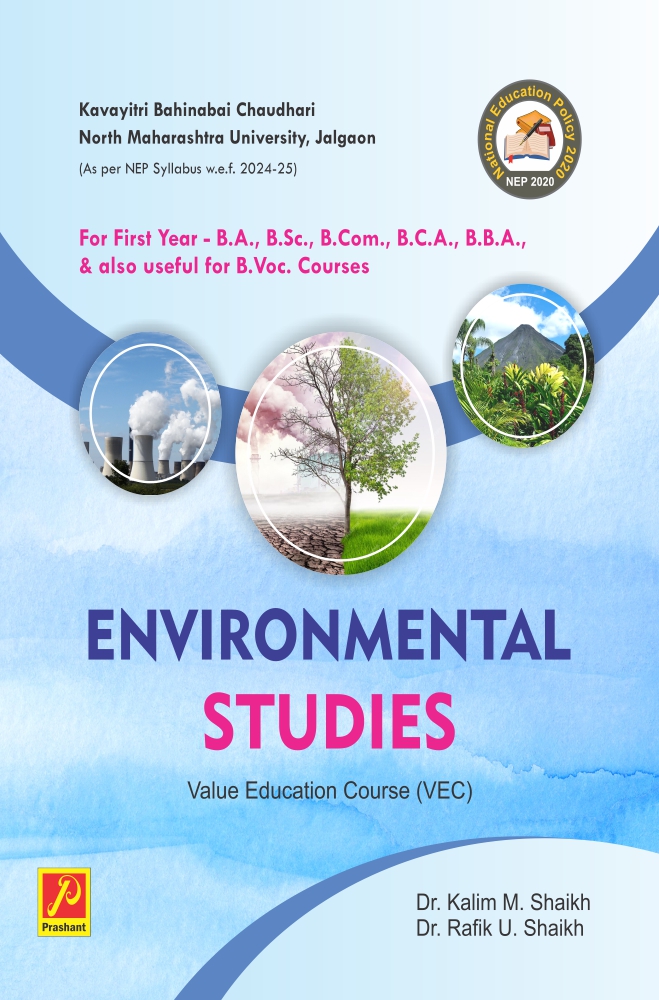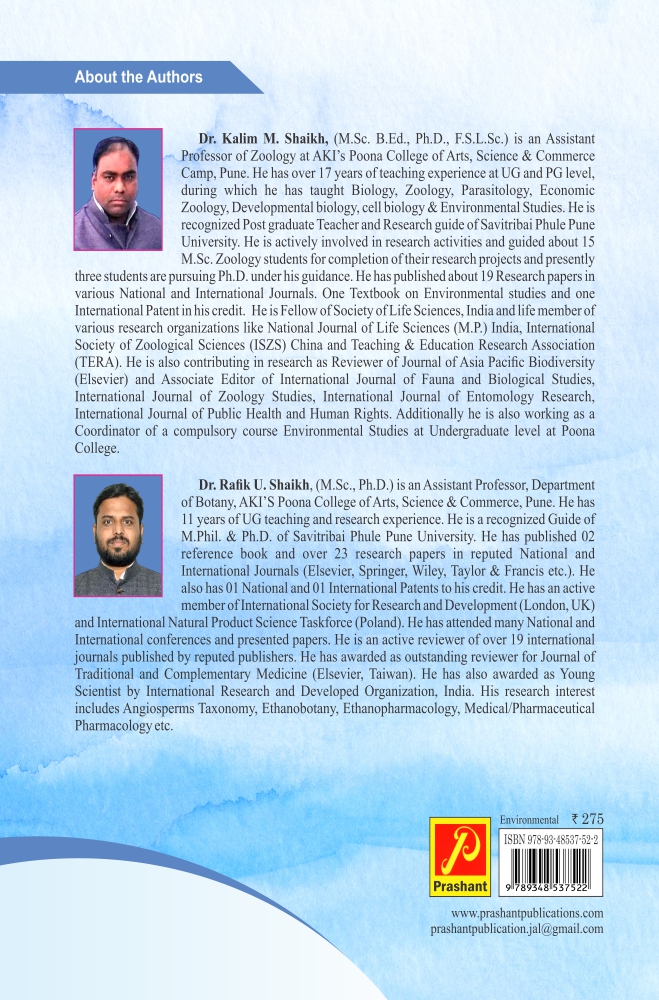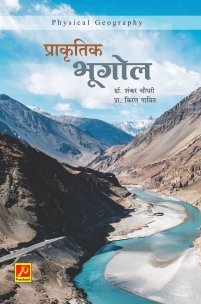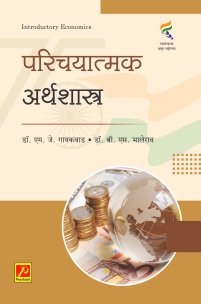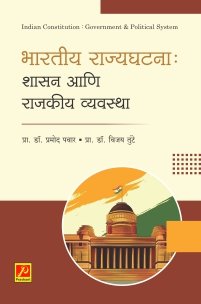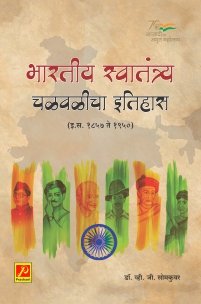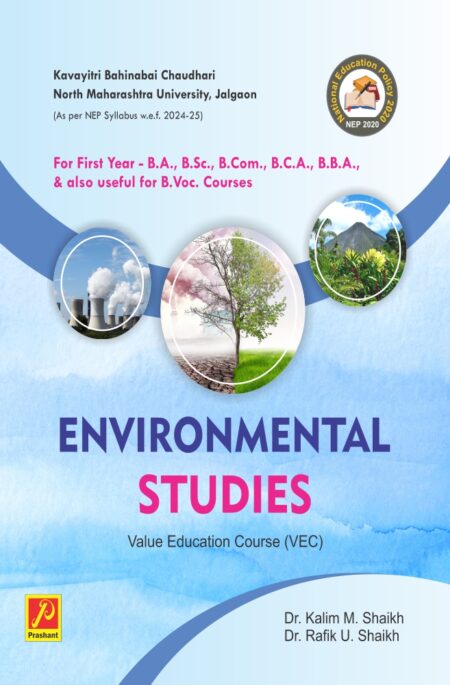Environmental Studies
For First Year - B.A., B.Sc., B.Com., BCA, BBA, & also useful for B.Voc Courses
Authors:
ISBN:
₹275.00
- DESCRIPTION
- INDEX
We are very glad to present this book on ES-115 “Environmental Studies” in the hands of First Year students of all streams and teachers. The book is strictly compiled according to the National Education Policy (NEP) pattern syllabus framed by the board of studies, KBC NMU, Jalgaon for First Year students and to be implemented from June-2022. The book is written in very simple language giving exhaustive details on topics included there in.
The authors, with their long experience in environmental teaching and research, took up the challenge and brought out a standard text book. The book is written as per the KBC NMU, Jalgaon and the various units associated with it, have been presented in a simple and lucid style to suit the requirements of the course. The exercise as descriptive answer questions and multiple type questions with their answer key are given at the end of each unit for practice are intended to reinforce the knowledge of the students.
This book covers the major environmental aspects as per the syllabus framed by the KBC NMU, Jalgaon, like major environmental ecosystems, natural resources, biodiversity and their conservation, environmental pollution, environmental policies and practices, human communities and environment and guidelines for field work study.
This textbook enables the students to develop an understanding of today’s most important environmental issues. It helps students to grasp the scientific foundation of environmental topics so; they can better understand the nature around them and their impact. This book will be useful to the students of Arts, Science, Commerce, Pharmacy and Management to understand the environment related subjects in their courses.
1. Environment and Current Issues
1.1 Ecosystem :
1.1.1 Introduction
1.1.2 Structure and function of ecosystem
1.1.3 Biotic Components
1.1.4 Abiotic Components
1.1.5 Function of an ecosystem
1.1.6 Energy flow in an ecosystem Energy flow in an ecosystem
1.1.7 Food Chains
1.1.8 Food Web
1.1.9 Ecological Succession
1.1.10 Case Studies
1.2 Current Environmental Issues :
1.2.1 Environmental pollution
1.2.2 Climate Change
1.2.3 Global Warming
1.2.4 Ozone Layer Depletion
1.2.5 Acid rain
1.2.6 Interdisciplinary nature of environmental studies
1.2.7 Concept of sustainable development.
2. Natural Resources and Biodiversity Conservation
2.1. Land resources and land use change :
2.1.1 Introduction
2.1.2 Land Resources and Land use Change
2.1.3 Land degradation
2.1.4 Soil erosion
2.1.5 Desertification
2.1.6 Causes and impacts due to development projects on environment
2.1.7 Biodiversity and Tribal Populations
2.1.8 Relationship between Biodiversity and Tribal Populations
2.1.9 Threats to Biodiversity and Tribal Populations
2.1.10 Role of Tribal Populations in Biodiversity Conservation
2.2 Water :
2.2.1 Use and over-exploitation of surface and ground water
2.2.2 Floods
2.2.3 Droughts
2.2.4 Conflicts over water
2.3 Energy resources :
2.3.1 Renewable Energy Sources
2.3.2 Non-Renewable Energy Sources
2.3.3 Use of Alternate Energy Sources
2.3.4 Growing Energy Needs
2.4 Biodiversity:
2.4.1 India as a Mega-Biodiversity Nation
2.4.2 Endangered and endemic species of India
2.4.3 Threats to Biodiversity
2.4.4 Ecosystem and Biodiversity Services
2.4.5 Ecological Services
2.4.6 Economic Service
2.4.7 Social Service
2.4.8 Ethical Service
2.4.9 Aesthetic Service
2.4.10 Informational Value
2.5 Conservation of Biodiversity
2.5 Ecosystem and biodiversity services:
In-situ and Ex-situ conservation of biodiversity.
3. Environmental Pollution and Policies
3.1. Environmental Pollution :
3.1.1 Introduction
3.1.2 Types of pollution
3.1.3 Air pollution : (Causes, Effects and Control measures)
3.1.4 Major causes of Air pollution
3.1.5 Effects of Air Pollution
3.1.6 Control measures of Air pollution
3.1.7 Water Pollution
3.1.8 Causes of water pollution
3.1.9 Effects of Water Pollution
3.1.10 Control measures of Water Pollution
3.1.11 Soil Pollution
3.1.12 Major causes of soil pollution
3.1.13 Effects of Soil Pollution
3.1.14 Control measures of soil pollution
3.1.15 Noise Pollution
3.1.16 Causes of Noise Pollution
3.1.17 Effects of Noise Pollution
3.1.18 Control measures of noise pollution
3.1.19 Nuclear Hazards and Human Health Risks
3.1.20 Nuclear Hazards
3.1.21 Sources of Nuclear Pollution / Hazards/ Radioactive Pollution
3.1.22 Human Health Risks
3.1.23 Control of nuclear hazards
3.2 Solid Waste Management :
3.2.1 Solid Waste
3.2.2 Types of solid waste
3.2.3 Solid Waste Management/Control Measures
3.3 Environment Legislations :
3.3.1 Environment Protection Act
3.3.2 Air (Prevention & Control of Pollution) Act
3.3.3 Water (Prevention and control of Pollution) Act
3.3.4 Wildlife Protection Act
3.3.5 Forest Conservation Act
3.4 International Agreements :
3.4.1 Montreal Protocol
3.4.2 Kyoto Protocol
3.4.3 Convention on Biological Diversity (CBD)
4. Human Communities and Environment
4.1 Human Population Growth :
4.1.1 Introduction
4.1.2 Impacts on Environment
4.1.3 Impacts on Human Health
4.1.4 Impacts on Human Welfare
4.1.5 Resettlement and rehabilitation of project affected persons
4.1.6 Case Studies
4.2 Disaster management: floods, earthquakes, cyclones and landslides :
4.2.1 Introduction
4.2.2 Earthquake
4.2.3 Cyclones
4.2.4 Floods
4.2.5 Landslides
4.3 Environmental Movements :
4.3.1 The Chipko Movement
4.3.2 Salient Velley Movement
4.3.3 Bishnoi Movement in Rajasthan
4.4 Environmental Ethics :
4.4.1 Role of Indian and other religions and cultures in environmental conservation
4.4.2 Environmental communication and public awareness, case studies (e.g. CNG vehicles in Delhi) :
Related products
-
प्राकृतिक भूगोल
₹595.00 -
परिचयात्मक अर्थशास्त्र
₹395.00



